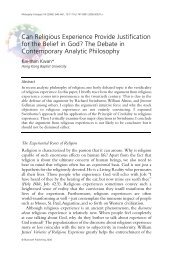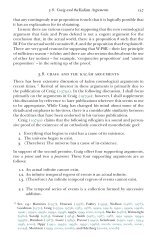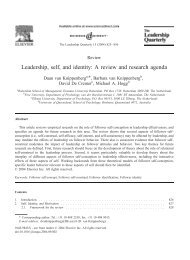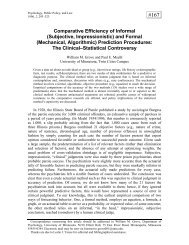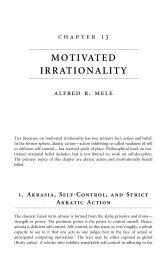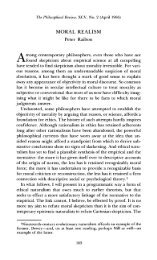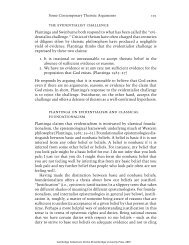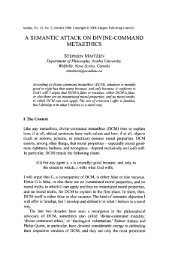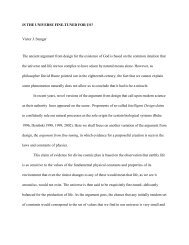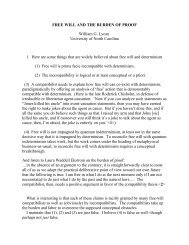Atheism and Theism JJ Haldane - Common Sense Atheism
Atheism and Theism JJ Haldane - Common Sense Atheism
Atheism and Theism JJ Haldane - Common Sense Atheism
Create successful ePaper yourself
Turn your PDF publications into a flip-book with our unique Google optimized e-Paper software.
200 J.J.C. Smart<br />
so-called quantifier ‘there is a’. Anselm needs a stronger <strong>and</strong> more suspect<br />
notion of modality such as is furnished by a semantics that talks of possible<br />
worlds other than the actual world. Later I shall briefly discuss an argument due<br />
to Alvin Plantinga which makes use of possible world semantics. 2 I shall not<br />
here press this consideration in discussing Anselm’s ‘can be thought’. In fact,<br />
Gregory Schufreider in his valuable book An Introduction to Anselm’s Argument<br />
3 says that the argument depends on the contrast between what can exist<br />
in the underst<strong>and</strong>ing alone <strong>and</strong> what exists in re. Thus the present King of<br />
France exists only in the intellect but the present President of France exists<br />
not only in the intellect but in re.<br />
In reply we may say that what exists in the intellect are ideas <strong>and</strong> concepts,<br />
so that unicorn ideas exist but unicorns do not. At bottom therefore I do not<br />
see whether as a proof Anselm’s is really better than Descartes’ one. Even if<br />
we have a concept of a being of which a greater cannot be conceived (after all,<br />
we seem to underst<strong>and</strong> the phrase), there still remains the question of whether<br />
this concept is instantiated, whether there is such a being.<br />
By interpreting Anselm’s use of ‘what exists in the underst<strong>and</strong>ing’ as<br />
simply ‘concept’, we have as things that exist not only stars <strong>and</strong> planets but<br />
the concept ‘star’ <strong>and</strong> ‘planet’, <strong>and</strong> the concept of a star or of a planet is not<br />
star or planet. So we have no need for two modes of existing (two senses of<br />
‘being’). W.V. Quine, in his essay ‘What there is’ in his From a Logical Point<br />
of View, 4 after discussing a benighted metaphysician McX, supposes a scarcely<br />
less benighted one, Wyman (note the pun!). Wyman wants to distinguish<br />
existence from subsistence. Russell did that at one time, so that he then<br />
thought that rabbits <strong>and</strong> stars exist but that mathematical objects only subsist.<br />
This, as Quine says, is to ruin the good old word ‘exists’. Just as rabbits <strong>and</strong><br />
lettuces do not have two kinds of existence, zoological existence <strong>and</strong> botanical<br />
existence, universals <strong>and</strong> numbers do not have non-spatio-temporal existence<br />
as opposed to spatio-temporal existence: there are just (in the unitary sense of<br />
‘there are’) both spatio-temporal rabbits <strong>and</strong> non-spatio-temporal numbers.<br />
In the Proslogion, after arguing that the thing a greater than which cannot<br />
be conceived can be identified with God (has the properties which we ascribe<br />
to God), Anselm argues:<br />
Only that in which there is neither beginning nor end nor conjunction of parts,<br />
<strong>and</strong> that thought does not discern save as a whole in every place <strong>and</strong> at every<br />
time, cannot be thought not to exist. 5<br />
He deduces this from the idea that what can be thought not to exist can be<br />
thought to have a beginning <strong>and</strong> an end <strong>and</strong> a conjunction of parts. Does<br />
Anselm here propose that God is eternal or that he is sempiternal? The<br />
sempiternal can be thought to have no beginning or end if it is thought that



